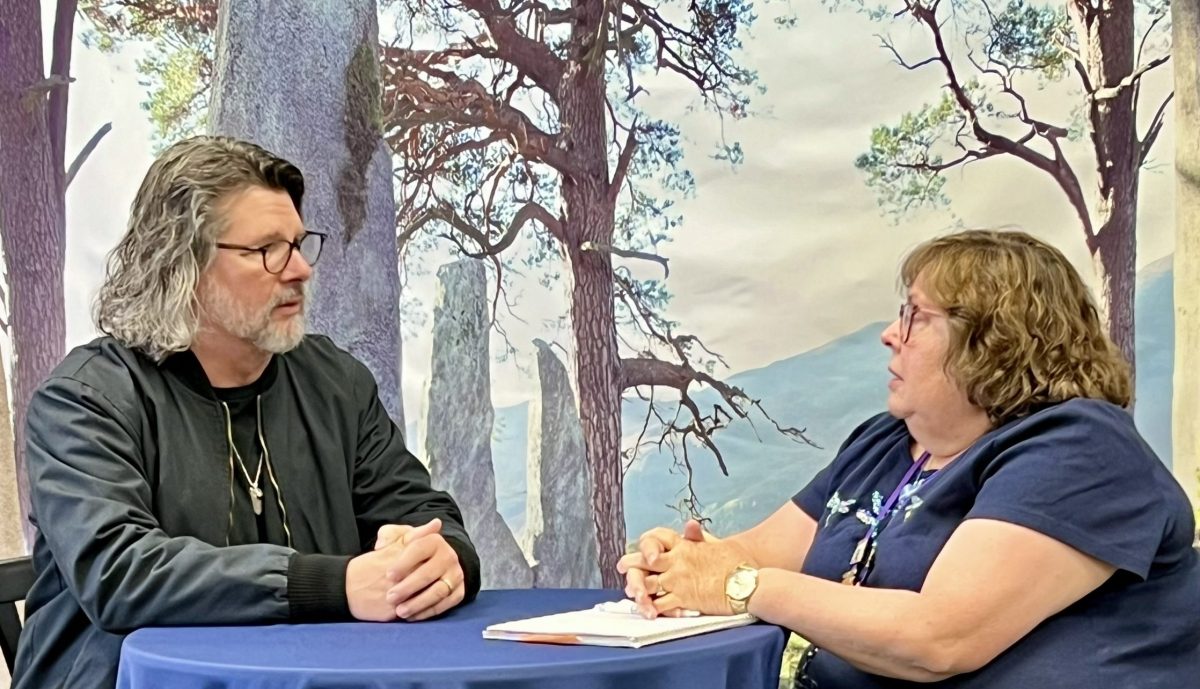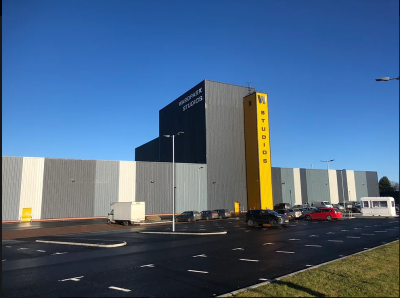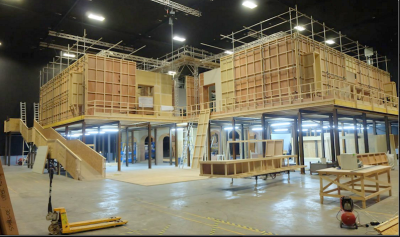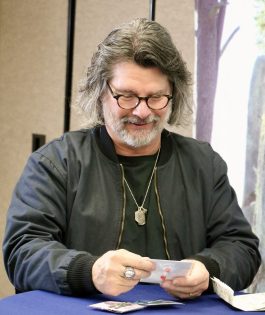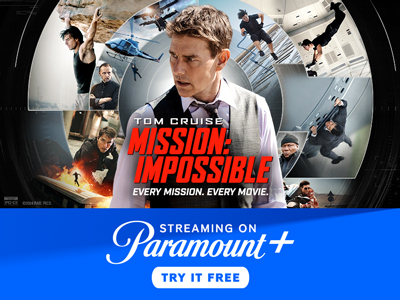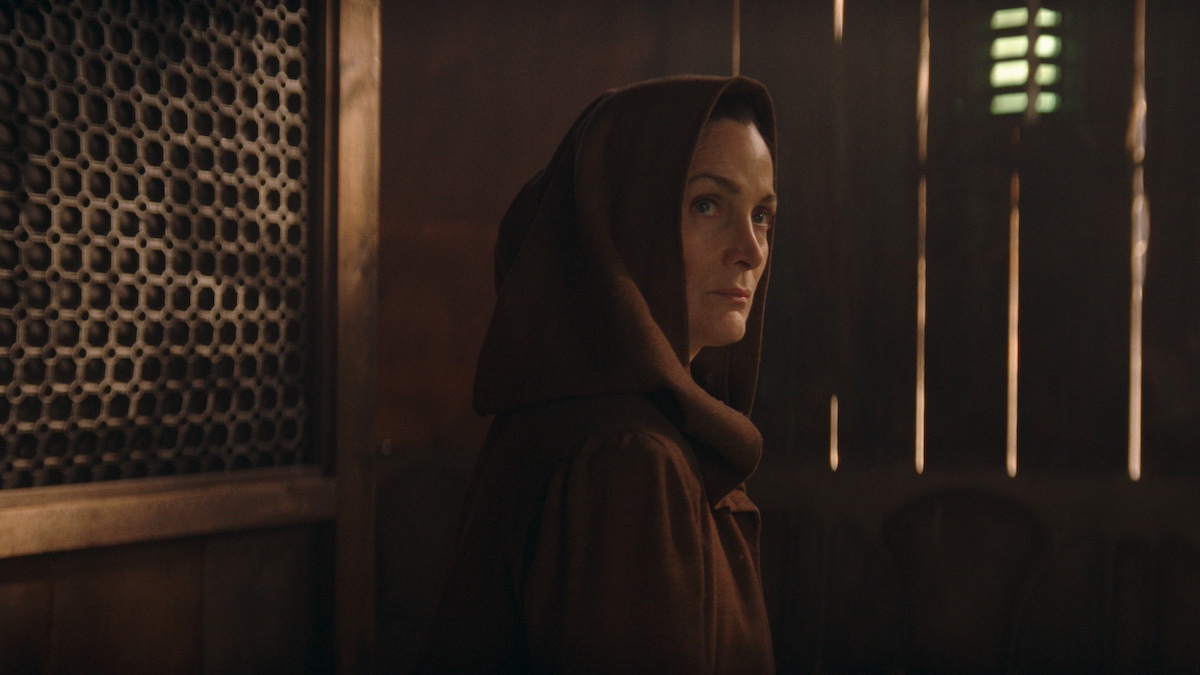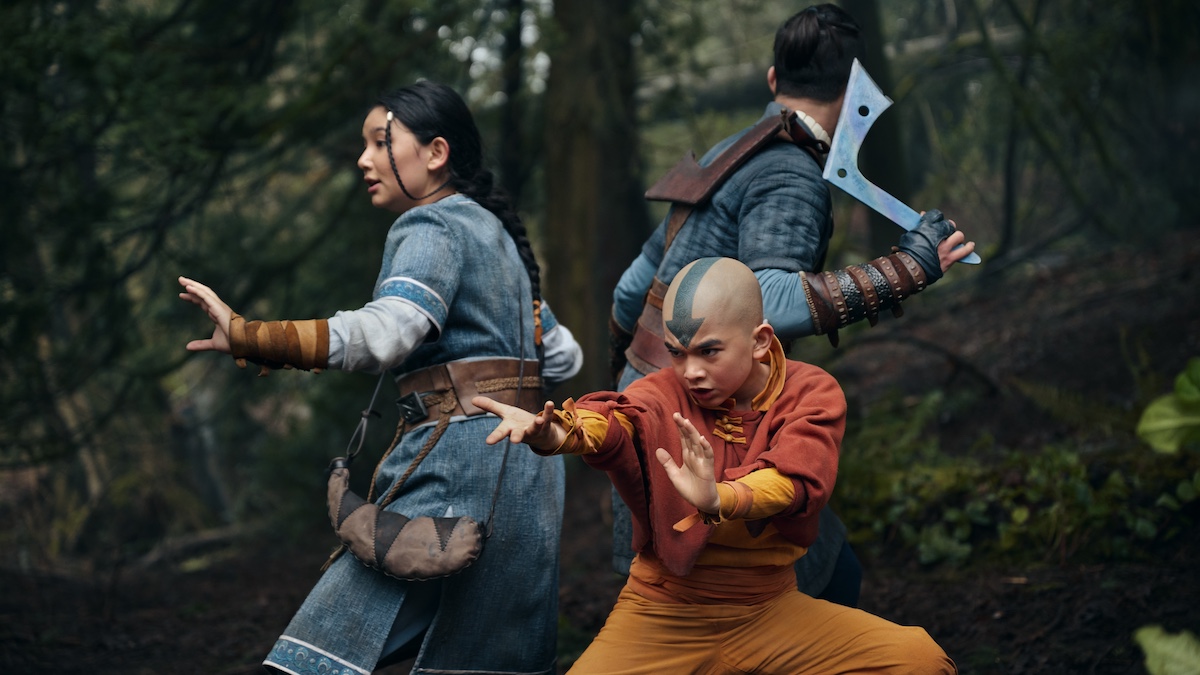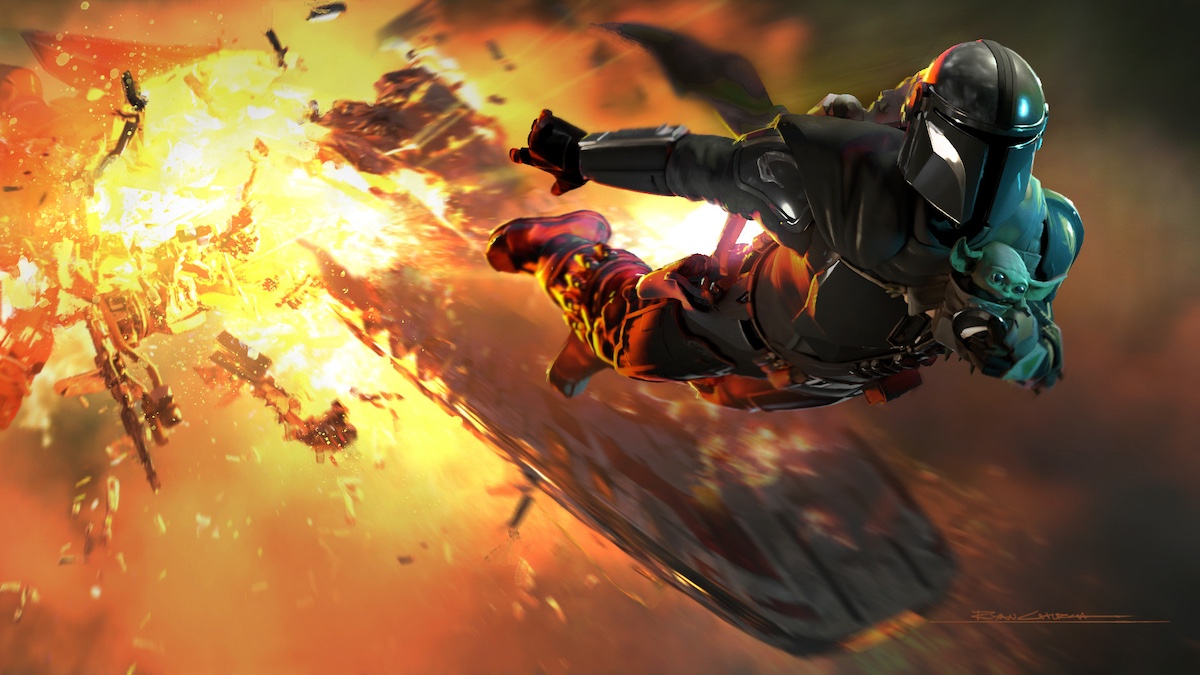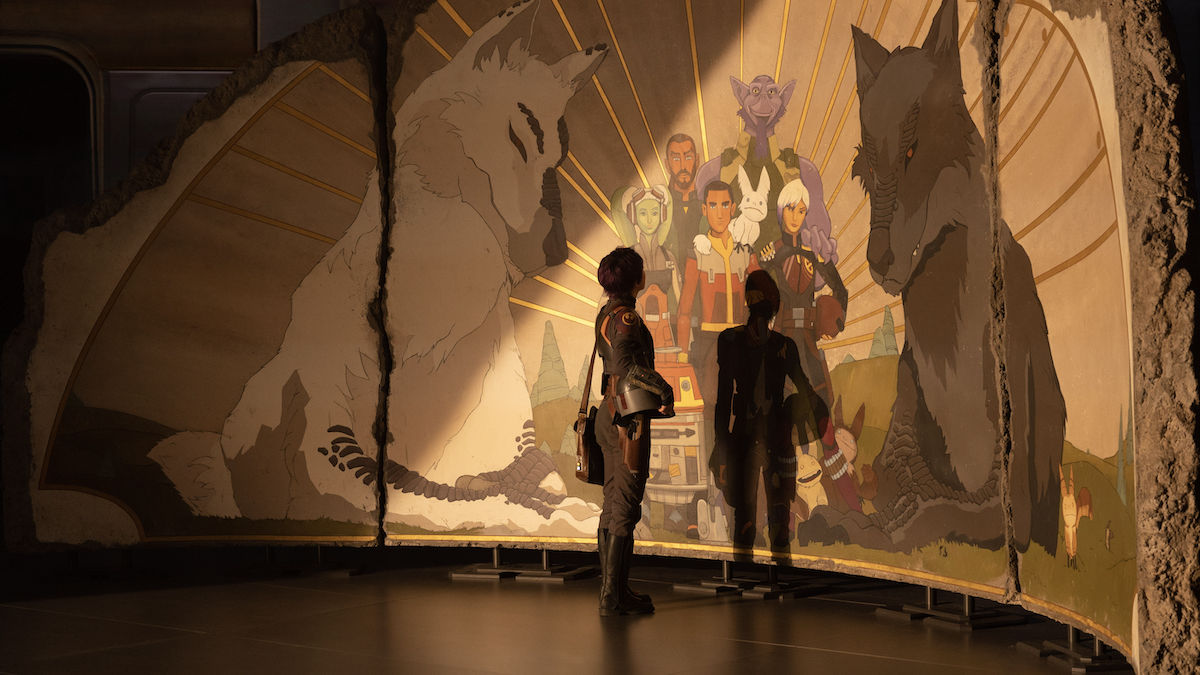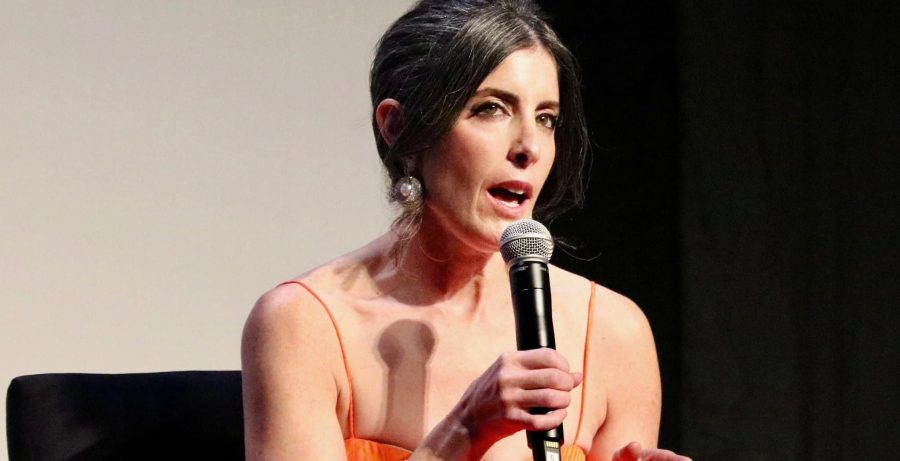Two weeks ago, at the final Thru The Stones event in Davenport, IA, I had an opportunity to chat with Outlander‘s Executive Producer, Ron Moore. Ron was a second-time guest at the event, attending in 2019 with his wife, costume designer Terry Dresbach. This, for me, was a thrill – I love having the chance to talk with the behind-the-scenes creators. The writers, artists, and those who put the show together are always fascinating. Of course, the half-hour we had to chat was nowhere near long enough for me, but the next day, the entire group was treated to a much longer interview by local TV newscaster Pilar Pedraza, and I’ve included some notes from that discussion as well! (By coincidence, Pilar and I covered a lot of the same material, so the answers Ron gave in that forum dovetail well with what he and I talked about.)
The videos below don’t cover all of our talk – there were some technical difficulties that I wasn’t aware of until after we finished, and I have to give a huge thank you to my friend Samantha Kraupner, who was taking stills – and once she realized that my phone was not behaving, filmed the last half of our talk. That will be the 4th video in this post.
I have to laugh at the beginning of this first video – I tend to get emotional when talking about certain subjects, and apparently, Outlander is one of those. Ron took it like the sympathetic and professional person he is. Here, Ron talks about what he finds different about Outlander than some of the other shows he has been involved with, which include a couple of the Star Trek series and Battlestar Galactica, among others. “I saw the possibilities on the very first read,” he told Pilar. “World building – it’s still a difficult build whether in the Klingon Great Hall or in Scotland. You had to believe that 18th century Scotland was real. The historic authenticity – I thought that was important. It mattered to fans, and you want to keep this as you do the project. It helped viewers to believe that Claire had actually time traveled. We worked hard to keep it real. Armorers, horse trainers – how did they ride, how did they look back then.”
One big issue that fans always complain about is that Outlander hasn’t won the awards we feel it should have. While the show has had several nominations for Emmys and other big awards, it has been consistently passed over. Ron talks here about how sci fi in general doesn’t get the recognition it deserves, and we discuss the lack of awards for Star Trek and Battlestar Galactica. But Ron believes that shows like Outlander and the others he has worked on have something better than fleeting awards – they’ll still be relevant, admired and watched years from now.
Of course, Ron’s wife Terry was the first and best choice for costume designer as they started the project. Terry had retired, but Ron convinced her to do this with him. “These (were the) hardest details to nail down,” he told Pilar, “because there aren’t too many details still around. It was a lot of work to figure this out – there’s not a lot of info on colors and dyes, etc., for example.” But when you’re working with your spouse, in a foreign country, on such a huge production?
And at a certain point in the production, Ron began to feel the need to work on new ideas. This is common with long-running shows – the first showrunner gets the series going, deals with all of the early details and the relationship with the network, then wants to move on to other different productions. For Ron, this was in the fourth season of Outlander, and he has passed on the daily duties to head writer Matt Roberts. “I’m my own first audience,” he told Pilar. I look for stuff that attracts me (as a viewer). I’m constantly thinking about what could be a show. You have to pitch to the powers-that-be regularly in this business – it keeps you creatively engaged.”
What one scene stood out to Ron, Pilar asked? “The wedding was a big one. It was a scary show to do. It was the f’in wedding! There were lots of pieces that made it complex. We spent a lot of time on editing – flashbacks, structure. It took an enormous amount of effort. I’m fond of the Frank episode. It wasn’t in the book, it was fresh terrain. It would expand the universe, flesh it out a little more. Frank had to be worthy of Claire, because she spends so much of the first season trying to get back to her husband. We had to understand why she spent so much time on this.”
The second season, in France, and the structure of the third season, he said, were favorites. His current role is “writer emeritus.” He wanted to give the team a chance to grow. Matt Roberts became the obvious choice to take over. “I knew my personal joy was connected to getting something started, putting it all together for the first time. Then comes the second year, can you do it again? But I started to think I’d like to start all over again. I got to the point where it was better to hand it off to someone else. Now, it’s really his show. I don’t give a lot of notes any more.”
Pilar discussed filming in Cumbernauld at Wardpark Studios, the studio that Outlander built in Scotland. “It was an abandoned circuit factory. There was no working heat, there was trash everywhere. But there were lots of professionals in the area who wanted to work closer to home. The area has had an amazing resurgence. We had access to people in the region who had done things we needed – we would have to recreate or bring things in if we filmed elsewhere.” Now, the studio has 200,000 sf with five sound stages, and is used for many different productions. To learn more, see their website here.
Pilar aske how much of what gets on the air is directly from the writers’ room vs what’s created during editing. About the same amount, Ron says. “The first time I ever got into editing was when I worked on Roswell. Whatever you thought you were shooting, this is what you actually shot. In editing, you can make discoveries about what you shot. Hold (the scene) one second longer, it’s funny. Slow the entrance into the scene, you create dread.” He told us that you can change the entire way you tell the story by editing it differently – change the structure, move flashbacks around (like in the Wedding episode), catch an expression used in a different take and change how the audience feels about the character.
Ron talked with Pilar about how he started being interested in science fiction. “It came out of watching the Apollo missions. It’s a bigger game of ‘what if.’ I enjoy playing with societies. What if these things had changed, what if the world was governed by different rules? It’s talking about us, making the audience think. You’re not forcing them to confront their political biases, but forcing the audience to think about things in a different way. You’re asking the audience to believe in something fantastical. You have to make the characters believable – the audience shows up for characters. How does it affect Claire or Jamie? What makes them identifiable, fall in love, and connect with other human beings? That’s what the audience is there for.”
Our friend Cathy McQuistion (Cats and Kilts) wanted us to ask Ron about the cameos he’s done and if he had plans to do more, specifically in For All Mankind (he had a cameo in Outlander’s Season 1 episode 4, as a guest at The Gathering). Ron said he had also done a cameo in Star Trek: Deep Space 9, as a holodeck character in the show’s final episode, and as a Starfleet officer in the fifth season episode Call to Arms. According to Memory Alpha, the Star Trek encyclopedia, he did a total of three Star Trek cameos, with one in the Next Generation movie First Contact. He also did a cameo on Portlandia, in a Battlestar Galactica-themed episode. I asked him, in the video below, about following in Stan Lee or Alfred Hitchcock’s cameo footsteps.
What’s happening with upcoming projects? Sarah J. Maas’ fantasy series, A Court of Thorns and Roses (ACOTAR), an announced Swiss Family Robinson series for Disney, and an Outlander spin-off are all on the table. (It was just announced that filming for Blood of My Blood will start in March, with no additional information provided.) Below, Ron briefly discusses the other projects, and talks about the issues involved in scheduling Blood of My Blood.
We also talked about what’s come out of this year’s writer and actor strikes. How does Ron think that will affect future productions? How will AI be used, should it be used? Terry Dresbach has been very vocal about crew conditions and hours, which was a focus of the actors strike that also affected all crew members – how has Outlander tried to make a difference? There’s also a reference to something that Thru The Stones’ other guests, body doubles Iain Wilkie and Valerija Jameljenko mentioned – that toward the end of filming a recent season, an ice cream truck pulled up for cast and crew – except extras and the body doubles were told they couldn’t partake. Ron was sitting in the audience as that story was told – his reaction is in the video.
Ron was an engaging, thoughtful guest, and I think the entire audience enjoyed hearing from him! Thank you, Pilar Pedraza, for your interview for our entire group.
For my recap of this Thru The Stones event, click here.
After this interview, I gave Ron a set of the three Outlander-related pins that I and our site owner designed – you can see and order those pins here in our Collectibles shop!
Join us on Facebook for Outlander news, discussion and fun!

